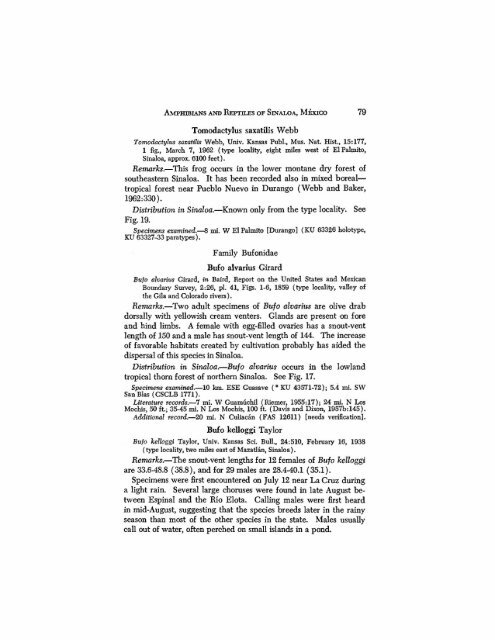The Amphibians and Reptiles of Sinaloa, Mexico - Smithsonian ...
The Amphibians and Reptiles of Sinaloa, Mexico - Smithsonian ...
The Amphibians and Reptiles of Sinaloa, Mexico - Smithsonian ...
You also want an ePaper? Increase the reach of your titles
YUMPU automatically turns print PDFs into web optimized ePapers that Google loves.
AMPHIBIANS AND REPTILES OF SINALOA, MEXICO 79<br />
Tomodactylus saxatilis Webb<br />
Tomodactylus saxatilis Webb, Univ. Kansas Fubl., Mus, Nat. Hist., 15:177,<br />
1 fig., March 7, 1962 (type locality, eight miles west <strong>of</strong> ElPalmito,<br />
<strong>Sinaloa</strong>, approx, 6100feet).<br />
Remarks.—This frog occurs in the lower montane dry forest o£<br />
southeastern <strong>Sinaloa</strong>. It has been recorded also in mixed boreal—<br />
tropical forest near Pueblo Nuevo in Durango (Webb <strong>and</strong> Baker,<br />
1962:330).<br />
Distribution in <strong>Sinaloa</strong>.—Known only from the type locality. See<br />
Fig. 19.<br />
Specimens examined.—8 mi, W ElPalmito [Durango] (KU 63326 holotype,<br />
KU 63327-33 paratypes).<br />
Family Bufonidae<br />
Bufo alvarius Guard<br />
Bufo alvarius Girard, in B<strong>and</strong>, Report on the United States <strong>and</strong> Mexican<br />
Boundary Survey, 2:26, pi. 41, Figs. 1-6, 1859 (type locality, valley <strong>of</strong><br />
the Gil a <strong>and</strong> Colorado rivers).<br />
Remarks.—Two adult specimens <strong>of</strong> Bufo alvarius are olive drab<br />
dorsally with yellowish cream venters. Gl<strong>and</strong>s are present on fore<br />
<strong>and</strong> hind limbs. A female with egg-filled ovaries has a snout-vent<br />
length <strong>of</strong> 150 <strong>and</strong> a male has snout-vent length <strong>of</strong> 144. <strong>The</strong> increase<br />
<strong>of</strong> favorable habitats created by cultivation probably has aided the<br />
dispersal <strong>of</strong> this species in <strong>Sinaloa</strong>.<br />
Distribution in <strong>Sinaloa</strong>.—Bufo alvarius occurs in the lowl<strong>and</strong><br />
tropical thorn forest <strong>of</strong> northern <strong>Sinaloa</strong>. See Fig. 17.<br />
Specimens examined.—10 km. ESE Guasave (° KU 43571-72); 5.4 mi. SW<br />
San Bias (CSCLB 1771).<br />
Literature records.—7 mi, W Guamuchil (Riemer, 1955:17); 24 mi. N Los<br />
Mochis, 50 ft.; 35-45 mi. N Los Mochis, 100 ft. (Davis <strong>and</strong> Dixon, 1957b:145).<br />
Additional record.—20 mi. N Culiacan (FAS 12611) [needs verification].<br />
Bufo kelloggi Taylor<br />
Bufo kelhggi Taylor, Univ. Kansas Sci. Bull,, 24:510, February 16, 1938<br />
(type locality, two miles east <strong>of</strong> Mazatlan, <strong>Sinaloa</strong>).<br />
Remarks.—<strong>The</strong> snout-vent lengths for 12 females <strong>of</strong> Bufo kelloggi<br />
are 33.6-48.8 (38.8), <strong>and</strong> for 29 males are 28.4-40.1 (35.1).<br />
Specimens were first encountered on July 12 near La Cruz during<br />
a light rain. Several large choruses were found in late August between<br />
Espinal <strong>and</strong> the Rio Elota. Calling males were first heard<br />
in mid-August, suggesting that the species breeds later in the rainy<br />
season than most <strong>of</strong> the other species in the state. Males usually<br />
call out <strong>of</strong> water, <strong>of</strong>ten perched on small isl<strong>and</strong>s in a pond.
















